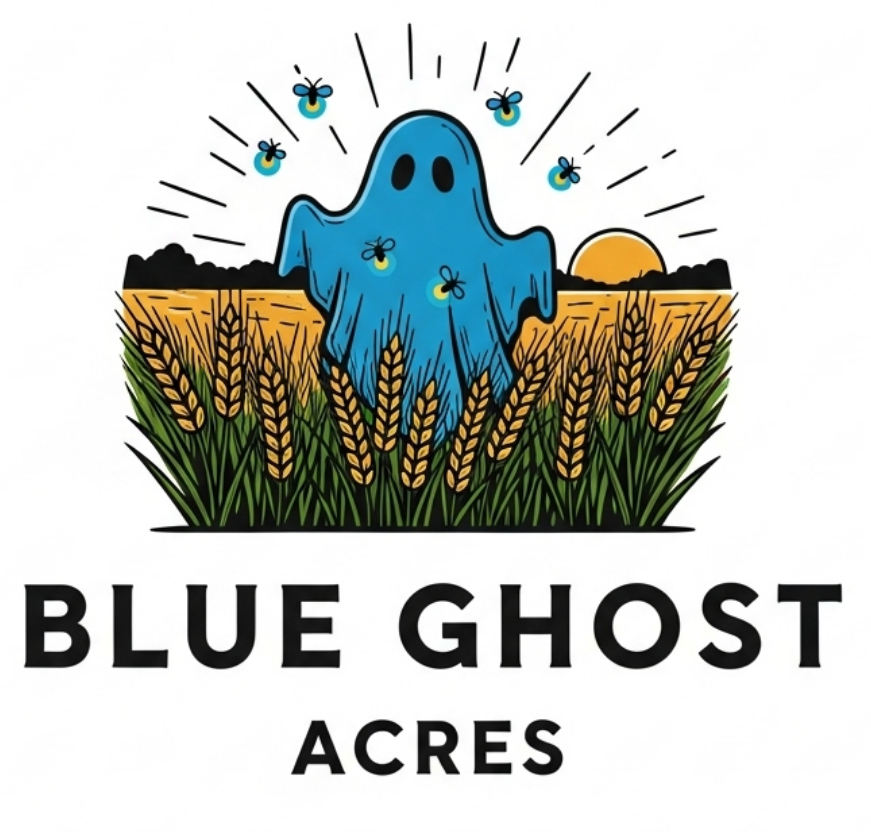Meet the Hardest Workers on Our Farm: The Honeybees of Blue Ghost Acres
When you think of farm animals, you probably picture something with feathers or fur. Chickens scratching in the yard, goats grazing in a pasture, maybe a sturdy livestock guardian dog. And while all those are part of our long-term vision, they weren't our first priority.
Our first and most essential animal workforce at Blue Ghost Acres is much smaller, far more numerous, and responsible for the health of entire ecosystems. We’re talking about our honeybees.
Our Apiary: A Humble Beginning
Our beekeeping journey began before we even closed on the land for Blue Ghost Acres. We started with a few hives, learning the quiet and fascinating art of tending to these incredible creatures. Today, we manage eighteen healthy colonies that are the quiet, buzzing heart of our operation.
In the beginning….
Look, no suit. Yeah…no. Learned the hard way months later helping another beek. NEVER AGAIN.
Currently, they live off-site while we undertake the heavy work of preparing their future home. A big part of our Year 1 plan is to build a dedicated apiary on the property—a carefully chosen spot with shelter from the wind, good sun, and access to the reliable water from our new well.
Why Bees are a Homesteader's Best Friend
For us, beekeeping is about so much more than just honey. Honeybees are a cornerstone of a healthy, productive homestead for several key reasons:
Pollination Power: They are a super-pollinator workforce. Having them on-site will dramatically increase the future productivity of our gardens, from our luffa gourds to the herbs and flowers we plan to plant. More bees mean more food. It’s that simple.
A Surprising Financial Benefit: This was the most critical role our bees played in our first year. In Texas, beekeeping can allow your land to qualify for an agricultural valuation, which significantly lowers your property tax burden. For us, maintaining our eight hives meant that our property taxes for our first year were only $107. This financial breathing room, while we invested heavily in infrastructure like fencing and a well, was far more valuable than any honey they could have produced. (Note: Tax laws vary by state and county, so be sure to check your local regulations!)
Indicators of Ecosystem Health: The health of our hives is a direct reflection of the health of the surrounding landscape. By observing our bees, we can learn about local nectar flows and the overall wellness of our local environment.
Delicious, Valuable Products: Of course, the rewards are sweet! There is nothing quite like the taste of raw honey from your own hives. Beyond honey, we can harvest beeswax for making salves and candles, and we have even made mead.
A Glimpse Inside the Hive
A honeybee colony is a marvel of efficiency and cooperation. Inside each of our hives, tens of thousands of individuals work together, each with a specific job:
The Queen: The single mother of the entire colony, she can lay up to 2,000 eggs per day.
The Worker Bees: These are all sterile females who do everything else: forage for nectar and pollen, build the wax comb, feed the young, clean the hive, and guard the entrance.
The Drones: These are the male bees. Their only job is to mate with a new queen.
For us, beekeeping is about stewardship. We see ourselves as caretakers, working in partnership with the bees, rather than just honey harvesters. Our goal is to ensure they are healthy, strong, and have everything they need to thrive.
The Future is Buzzing
While we wait for the day we can safely bring chickens and other livestock to the farm, we're proud to have our tiny, winged workforce leading the charge. They are a quiet reminder that the smallest things on a homestead often have the biggest impact.
As we build their new home here at Blue Ghost Acres, we look forward to sharing more of our beekeeping journey with you—and eventually, a taste of the golden honey they produce.



